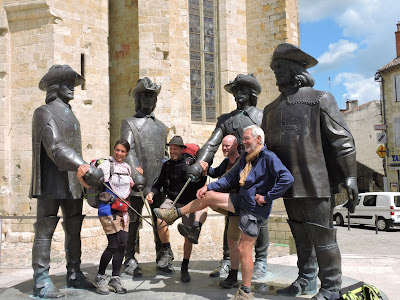 |
Carcassonne |
 |
Liste between the walls |
 |
Inner Chateau |
So how did
Carcassonne get its name? Legend has it, that the town was being besieged by
Charlemagne. Dame Carcas suggested that even though they were starving that they
overfeed the last remaining pig with grain and then throw it over the wall at
the invading force. When they saw this fat pig, the army assumed that there was
plenty of food and water remaining in the fortress and gave up the siege. The
church bells rang to signal the end of the siege to their hero Dame Carcas.
Thus the name Caracassonne, sonne means ring.
This is the last day of the trip. If you want to see more pictures, there is a narrated 15 minute video on youtube.
So how do I sum up this trip? It's one of the first trips we've had where the highlight of the entire trip was the post-trip: Toulouse, Albi, Lautrec, and Carcassone. The riverboat experience was among the best (other than cabin size). I read the itinerary beforehand, but I was still surprised by how many chateaus and vineyards we visited. If you're interested in Bordeaux wine, this is a great trip. But as is usually the case, the program director and guides make or break the trip. Marie, was superb, she would stop people, tell them that she was leading a group of Americans, and ask them to tell us about themselves or the sites we were seeing. We met two mayors, a Dominican priest, several school groups (one of which sang 'happy birthday' to one of our members), a gardener, and several random folks we encountered. Marie has unique talent at getting people to interact. Our local guides were also superb, particularly our guide in Chartres (we learned a lot about stained glass windows and Renaissance statuary), our guide to Toulouse and St. Emilion, and our guide in Carcassone (who really explained the history and architecture of the place. Finally, our group was great, always on-time, always curious.
This is the last day of the trip. If you want to see more pictures, there is a narrated 15 minute video on youtube.
So how do I sum up this trip? It's one of the first trips we've had where the highlight of the entire trip was the post-trip: Toulouse, Albi, Lautrec, and Carcassone. The riverboat experience was among the best (other than cabin size). I read the itinerary beforehand, but I was still surprised by how many chateaus and vineyards we visited. If you're interested in Bordeaux wine, this is a great trip. But as is usually the case, the program director and guides make or break the trip. Marie, was superb, she would stop people, tell them that she was leading a group of Americans, and ask them to tell us about themselves or the sites we were seeing. We met two mayors, a Dominican priest, several school groups (one of which sang 'happy birthday' to one of our members), a gardener, and several random folks we encountered. Marie has unique talent at getting people to interact. Our local guides were also superb, particularly our guide in Chartres (we learned a lot about stained glass windows and Renaissance statuary), our guide to Toulouse and St. Emilion, and our guide in Carcassone (who really explained the history and architecture of the place. Finally, our group was great, always on-time, always curious.
















































